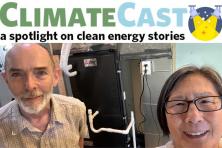Each month, ClimateCast features a Story Spotlight, covering climate issues and clean energy solutions that prioritize human experiences and connections in communities across the Pacific Northwest.
Every winter, just like clockwork, misleading news stories pop up about electric vehicles “struggling” in cold weather, clean energy investments “not being effective” when temperatures fall, and the alleged “inevitable” need for gas and oil despite their numerous inefficiencies, health hazards, and climate pollution.
We’re here to share examples from across the country and around the world that ought to close the confidence gap once and for all: yes, clean energy does work during cold weather. There are plenty of examples, including wind power working in cold climates like Norway, electric heat pumps delivering warm air down to 5° F, and electric school buses running in the frigid temps of South Dakota.
Fossil gas does not solve power outage problems
A common fallacy propelled by the fossil fuel industry is to claim that homes need gas appliances “in case of power outages” — yet virtually all other home heating systems still require electricity to operate. Electric heat pumps and resistive heaters obviously use electricity. Furnaces that burn gas, propane, or heating oil also rely on electrical components, as do gas-powered ovens, clothes dryers, and water heaters. Wood-burning stoves and fireplaces can heat their immediate surroundings without electricity, but good luck moving that heat anyplace else without power.
As for cooking, some gas stoves may work without power for cooking, but they should never be used to heat spaces. Also, using them without proper ventilation is a really bad idea. So, if gas doesn’t work, how do we stay warm inside if the power goes out?
The beauty of battery backups
If a power outage does occur, a highly efficient electric heat pump can be configured to draw power from in-home battery packs. Combining an electric vehicle with the latest generation of electric heat pumps, rooftop solar panels, a battery array to store generated energy on-site, and passive energy efficiency home upgrades can make a home uniquely resilient when temperatures plummet.
Another form of battery backups is rolling closer to all communities, the batteries in many electric vehicles can also give power back to a house; a charged-up electric vehicle can power a home when the grid does go down.
All vehicles can struggle in extreme cold
Regardless of their energy source be it fossil fuel or clean electricity, most vehicles suffer when temperatures plummet. Gasoline and diesel-powered engines rely on lead-acid batteries to start up and power critical systems, the performance of which degrades sharply in the cold. Electric vehicles don’t need a starter, but experience temporary range loss and increased charging times as ambient temperatures drop.
If you own or lease an electric car, leaving it plugged in and setting up preconditioning allows the vehicle to warm up the cabin and battery compartment before you leave. Battery heaters are also available to mitigate EVs’ cold weather issues.
On top of that, over half of daily car trips in the United States are less than three miles, and almost nobody embarks on a long road trip when winter storms loom (please stay safe!). Finally, if you must drive in sub-zero conditions, an electric vehicle that starts up without issue but has limited range is far more useful than a gas vehicle that can’t start up at all.
Yes, efficiency and grid upgrades too:
Energy efficiency upgrades — like adding thermal insulation, protecting the home’s thermal and air pressure envelope, and sealing up doorframes and windows — help to keep warmth inside longer. That’s already a win for your energy costs every day even when the heat pump is on.
Finally, investments in our nation’s power infrastructure will pay massive dividends in the form of more reliable electricity for everyone. Texas is already making great strides in a much more reliable grid, and the cold snap this winter showed a modern and reliable grid is key for unpredictable climate chaos.
More solutions visible soon
All this clean energy tech is rapidly becoming more affordable and accessible–and also more visible in more communities--thanks to billions of dollars in benefits coming soon including from the federal Infrastructure Investment and Jobs Act (IIJA) and the Inflation Reduction Act (IRA), as well as state programs like Washington’s Climate Commitment Act.
3 things you can do
1) Download and/or bookmark our climate conversation card in the resources section of our website for more ways to talk about climate in your community.
2) Find this story on our social media channels to share with your circles of influence!
3) Forward this email to a friend with this link if they want to get more story spotlights in their inbox too!





